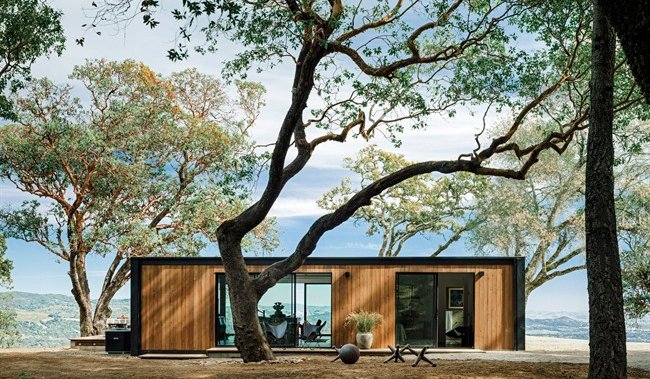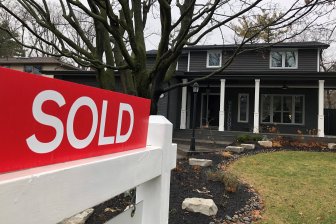Could Manufactured Homes Solve Canada’s Housing Crisis? “It’s like an orchestra” – National
Canada faces a housing crisis — the number of houses needed in the country keeps increasing, but not the number of people needed to build these houses. As homebuilders and policymakers grapple with this problem, some may find answers in “prefab” homes, experts say.
“Prefab (or prefabricated) housing is a form of housing where the building blocks are constructed in a factory rather than on site,” Matti Siemiatycki, director of the University of Toronto’s infrastructure institute, told GlobalNews.
Homeless encampments in Canada are on the rise. Experts advocate “Housing First” approach
Read more
“By manufacturing in a factory, it means construction can be done more precisely and it saves on energy costs,” he said.
Not being built on site also saves on labor costs, Siemiatycki added.
What exactly is a prefabricated house?
Prefab homes have been all the rage lately, from tiny houses posted on Instagram, to popular choice for an Airbnb stay, to Elon Musk living in one himself.
Since last year, the billionaire has been residing in Boca Chica, Texas, in the company’s 375-square-foot energy-efficient prefab home. Boxable.
The model home, known as the Casita, starts at around US$45,500 and is delivered to the customer in the back of a semi-truck.

Some companies, like Roombus, even integrate software into their design to create smart prefab homes. Roombus’ Nest homes come with the company’s RoomOS software that can be used to unlock your home, adjust lights and control the climate, all with a phone.
Prefab homes have been popular in waves throughout history, such as in the UK after World War II following a housing shortage, according to Siemiatycki.
“There is a long history of prefabricated houses. It used to be that you could buy them from a Sears catalog,” said Siemiatycki, who is also a professor of geography and planning at the University of Toronto.
Between 1919 and 1928, Sears, Roebuck & Company sold home kits from its “Modern Home Program”, according to the James A. Garfield National Historic Site. A house has even been named “The Garfield” in honor of the 20th President of the United States.
In Canada, many homes are typically built using the “stick construction” method — unlike manufactured homes, where the house is delivered after it’s built, according to Siemiatycki. Stick construction means that the materials are assembled on site.
“It’s interesting that we’re going back to (prefab) now because we’re in a housing crisis,” he said. “You hear a lot of emphasis on prefab housing, and it’s become more popular.”
With the increase in demand, there has been an increase in the number of companies creating prefabricated homes, although none has yet dominated the market, Siemiatycki said.
“These companies have struggled to establish themselves. There’s a lot of talk about it, but if it’s really going to spread who’s going to become the dominant player is still really up for grabs,” he said.
Prehab homes are ‘pretty common’ in Canada
For Sasha Weekes, 28, and her boyfriend, to move into a 608 square foot prefab house in the center Prince Edward Island has helped “significantly reduce our expenses”.
“On the East Coast they’re quite common, especially now with the housing crisis,” she told Global News.
Weekes’ home qualified for a mortgage with Canada Mortgage and Housing Corporation.
The biggest problem, however, was the delay Weekes faced in getting his prefab home delivered amid construction setbacks.
“People think a prefab house will be a faster option, but you have to do a lot of site preparation and then you have to wait for the house to be built and you have to wait for it to come,” she said.

When his house finally arrived, two months were spent having the septic tank and electrical installations dug, before he could move in.
“I think a lot of people our age on the East Coast who were overpriced must have used that option,” she said.
“They’re really well built and they’re a better option (price-wise),” she said, but you have to be prepared for the wait.
Part of the solution to Canada’s housing crisis could be increasing supply and according to Siemiatycki, “this is where prefab housing can have a big opportunity.”
Manufactured homes can be built faster than regular homes, according to Adam Dumond, designer at Royal Homes in Ontario.
“It’s like an orchestra,” he told Global News. “The house was built around the same time. Framing, windows and roofing – all of this can be done simultaneously in a prefabricated house.
“It’s a really, really cool alternative to stick framing. Teams are happy to have your house built indoors while the weather does what it does,” Dumond added.

Once the house is built, it is delivered in modules to the client’s property for assembly.
“A crane comes in, then we pick up the house and put it on the foundation, one module at a time,” Dumond said.
On average, Royal Homes sees around two and a half modules per home for something in the 1600 to 1800 square foot range. Each square foot ranges roughly between $350 and $450, depending on where you live, Drummond said.
This means that a 1,600 square foot house could cost between $560,000 and $720,000 and an 18,000 square foot house between $630,000 and $810,000.
“We have houses that are a bit cheaper (in price) and obviously houses that are a bit more expensive. It really depends on where you want to build,” he said.
In Ontario, the average price of a home was $829,934 in November 2022, according to the Canadian Real Estate Association.
City and province accelerate construction of 90 new homes to help solve Vancouver’s tent cities
While a manufactured home may be cheaper than the average home price in the province, purchasing land on which it can perch is also a factor that should be considered.
“Every site is a little different,” Dumond said. Care should be taken with properties near areas of water loss or rock formations, he warned.
Siemiatycki agrees.
“We have to be very careful that people don’t buy in places that are prone to flooding or wildfires. We have to be very careful not to build in low areas or areas that are right at the interface of urban wildlife.
In Ontario, nearly two-thirds of residents spend more than 30% of their household budget on housing, according to a recent study survey of the Ontario Real Estate Association (OREA).
Despite the rising cost of living putting pressure on Canadians, seven in 10 non-homeowners in Ontario identify as someone who “really wants to own a home,” according to the survey.
And in Ontario, as well as British Columbia, high interest rates are expected to continue to hold back homebuyers in the new year, according to a recent report from RBC.
When it comes to architecture and design, prefab homes tend to be “repetitive,” according to Siemiatycki.
Bringing personal touches into the home can also get tricky.
“There’s always a tradeoff with prefabrication on how much customization you want to do before you lose the benefits — the economies of scale of building in a factory,” Siemiatycki said.

For manufactured homes to really make their mark on the Canadian housing market, there is a need to ramp up production, Siemiatycki said.
“If part of the supply is to be supplied by modular, whether for single-family homes or multi-dwellings, there will be a huge need for capacity in the market that is not even available currently”, a- he added. .
Durability can also differ when it comes to prefab homes, according to Siemiatycki.
“It varies depending on how it’s built and how long it lasts,” he said. They must come with a history of durability in locations that are “vulnerable to environmental conditions.”
“We continue to need good planning and making sure that where we are building is safe to build and not vulnerable, otherwise you are just creating real additional challenges for all people involved – municipalities, first responders, and for the people who ultimately live in these homes,” he said.
What to consider when in the market for a prefab home
It’s important to look for a “reputable” company, according to Siemiatycki.
“It’s about thinking about (not just) who actually makes it, but also who assembles it,” he said.
Another thing to keep in mind is whether the property can be rented out or resold later, Siemiatycki added.
“There’s a lot of research that goes into buying a home. For many Canadians, this will be the biggest purchase they will ever make,” he said.







Comments are closed.